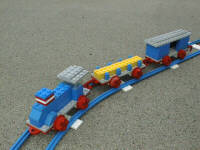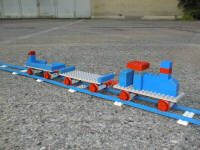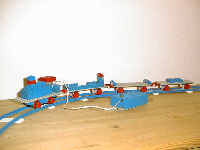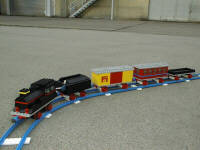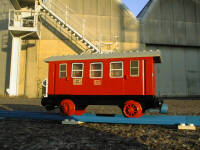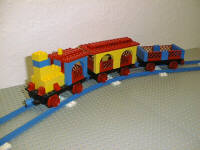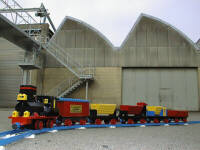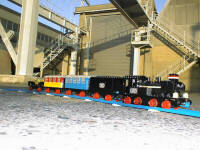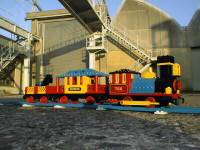All Train Sets of the Blue Era (1966 - 1979)
![]()
![]()
![]()
![]()
![]()
![]()
![]()
![]()
![]()
![]()
![]()
![]()
![]()
![]()
![]()
![]()
![]()
![]()
![]()
Sets sorted by number
113:
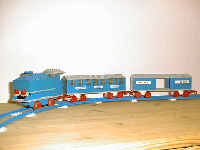 |
This is very first motorized train set from 1966. The same blue steam
engine as in set 112 above. The only difference is the missing front coupling
of the 113 engine. Very rare parts
are the printed bricks with 'Hamburg', 'Basel' and 'Genova' and 'Post'.
As now known for sure, there have been 2 versions of the 'Post' bricks: the others have an old-fashioned horn beneath the letters (as given in Clark's gallery of printed bricks). Such a train is to be found in perfect condition in a toy museum in Mechelen/Belgium. (Sidenote: the UK version of the 113 has had 'London', 'Manchester', 'Glasgow' as train destinations and 'Royal Mail' instead of 'Post'.) The 1x2x1 transparent bricks in the picture on the left are probably the only correct version: all 'perfect' 113 models (I have ever heard of) have had the bricks without center cylinder inside. |
116:
 |
Starter train set 116 from 1967
was the first black steam engine and has one of the rare high type 4.5
V motors and battery boxes like the ones from set 102 but in black.
(Notice: at least in Belgium the 116 train has been in the catalogue in an updated version with 103 motor, spoked wheels and magnet couplings. Same couple has been in the German catalogue as set 127 but I doubt, it has ever been available here. All sets 127 - I ever have heard of - have been located in the UK.) Additional note on 116: This set has been sold in at least 2 versions: the first as seen above, a second has had spoked wheels, motor and batterie box in set-103-style and as a special highlight this later version has had goldprinted bricks with the number 116 on them (and again of these gold bricks there exist at least 2 version: center 116 print and out of center). For the windows of the passenger coach it seems there have been used both brick types: those 1x2x1 with center cylinder and those without. |
118:
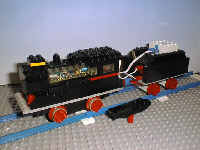 |
This picture shows number
118 Electronic
Train from 1968. This engine is quite similar to the later 138, but it
uses the characteristic
old type
motor and batteriebox as they were still in use 1968 when this set
was released (but in fact a very special one - the red dot marks where
to attach the red plugs). You can control this train and let it drive forward
and stop again by whistling in a certain high tune. That specific whistle
lies in front of the track. Find out more about that electronic on the
motor
history site.
Note on 118: As all the other sets with the black 102 type motor, the 118 set has been sold as a updated version also. But only in this special case the second version was concerning just the batterie box, which got updated, while the motor left unchanged in the second version. The white microphone got modiefied too: the picture on the left shows the first version, the picture of 138 the later version as also used in 118. |
| 125:
|
This is the tipper truck from set 125 (1969). It was also used in the train set 120, but has a different colour (here red, in 120 in black) of the 2x4x1 brick above the wheel holders. |
| 130:
|
Set 130: waggon with double tipper from 1972 |
132:
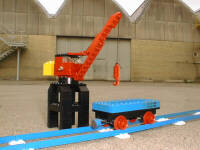 |
"Port Crane and Flat Wagon (132)" from 1972. Part of the crane are two transparent sloped bricks in 1x2x1. The printed bricks on this waggon are the same as used in set 124 (see above). |
| 133:
|
The next generation of push along engines: the set 133 from 1975 uses the nice yellow rods. This one has even it's old stickers applied since it's first days then. |
134:
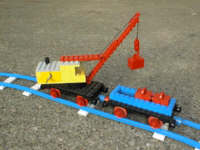 |
Another early crane waggon in a couple with a flatbed, the set 134 from 1975. But no printed bricks any longer... |
| 136:
|
Here is the first tanker waggon (set 136, 1975). It was the first in a long line of further shell and later Octan tank waggons. |
137:
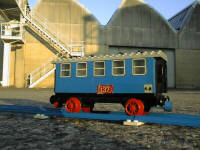 |
This 137 sleeping car from 1975 seems to be one of the often sold sets of the blue era, since you can find it quite often in eBay auctions. |
| 138:
|
The electronic train 138 from 1969
was a highly expensive train those days, but it has a great feature: it
starts to work when a whistle is blown, but nearly all kind of loud noise
will do the same. Then it starts to drive in one direction, after a second
whistle it stopps again. A long signal makes it drive rearwards and next
makes it stand still again.
A very special part of this rare set is the transparent electronic block, which was sold also as set 139 in combination with the white microphone (here on back of the the tender). The cable with the red plugs is used just in this set (prelimenary set 118 uses similar, but singulary plugs. Only the later original plugs should have the 'Lego' logo visible) The outlets on the electronic block and the microphone have dots in blue and red to mark the right cable assembly. Above you can see the blue point on the white microphone quite well. (But the red dot on the battery box is missing). If you like to learn more about that electronic, please visit the motor history site. |
| 147:
|
Set 147 from 1976: 'Refrigerated Car with Forklift' with two of the armless pre-minifigs. |
| 163:
|
Here is the main model of set 163 (1977): A crane waggon with a small flatbed car. |
163b:
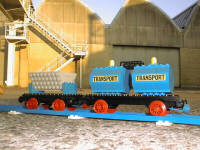 |
This is the alternative model of set 163 from 1977 including a tank waggon and the very rare grey tipper waggon. |
166:
 |
This set seems to be build out of common bricks only, but set 166 Flat Wagon from 1978 (or 1979?) contains the very rare yellow helmet. |
| 167:
|
One out of two sets with a yellow helmet. But even harder to find are the black fence doors from the car transport wagon and loading ramp (set 167 from 1978/79?). |
171:
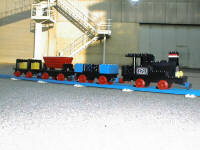 |
From the same year, but somewhat more realistic than the one above: push along train 171 from 1972. |
The numbers from 720 up have been 12V trains:
| 721:
|
Here is a closeup of the single sold 721 engine (from 1969). As said above it was identical to the engine of train set 720 exept from it's brick with goldprinted number. |
722:
 |
|
| 724:
|
Here is the first diesel engine LegoŽ ever released: set 724
from 1972. The train is completed with a tipper and a crane waggon. It
has a very primitive crane with a funny working principle. You have to
turn the crane to let the hook go up and down.
Note on 724: The picture above shows the 724 as I got it, but there is one mistake: the real 724 has always had the glued none-printed doors from the latest generation of the trucks with steering. You can easily recognise this by looking at the door handle, which should be in horizontal direction instead of vertical. |
More old train sets like 146 Level Crossing, 148 Central Station or Shell refueling station 149 can be found separately under the section 'Train Buildings'.
How the development went on: Grey Era from 1980 - 1990.
|
[back to the LegoŽ trains page] ... |
Last updated: may - 31st - 2004
visitors since sept.-20th-2002
